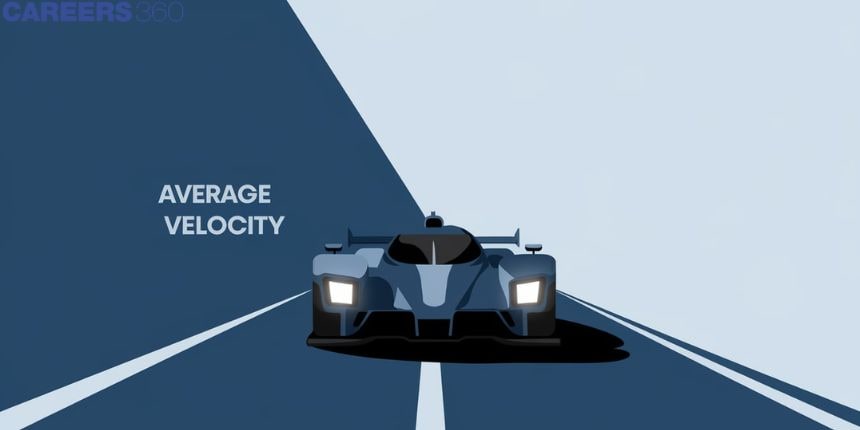Average Velocity - Definition, Formula, Difference, FAQs
When an object moves, its position changes with time, and average velocity helps us understand how fast and in what direction this change happens. In this article, you will learn what average velocity means, how it differs from average speed, and why this difference is important in physics. Students often confuse the two, but average velocity depends on displacement, not total distance. Understanding this concept is very helpful for solving motion problems in Classes 9 and 11 and for building a strong base in kinematics. By reading this page, students will learn the definition, formula, important cases, and solved examples of average velocity, helping them understand real-life motion more clearly and accurately.
This Story also Contains
- What is Average Velocity?
- Different Cases of Average Velocity
- Average Speed and Average Velocity Similarities
- Difference Between Speed and Velocity

What is Average Velocity?
Average velocity is defined as the total displacement of an object divided by the total time taken. It tells us how fast an object changes its position in a particular direction.
$
\text { Average Velocity }=\frac{\text { Total Displacement }}{\text { Total Time }}
$
- Average velocity depends on displacement, not distance.
- Displacement is the shortest straight-line distance between initial and final positions.
- It is a vector quantity, so direction is important.
- Average velocity can be zero even if the object has travelled a long distance (example: coming back to starting point).
- Its SI unit is $\mathrm{m} / \mathrm{s}$.
- If the motion is in a straight line in one direction, average velocity becomes the same as average speed.
Different Cases of Average Velocity
Average velocity depends on the type of motion or situation. Below are the common cases:
1. Average Velocity for Uniform Motion
When the velocity remains constant throughout the motion,
Average velocity $=$ constant velocity
2. Average Velocity for Non-Uniform Motion
When velocity changes during motion,
$
\text { Average velocity }=\frac{\text { Total displacement }}{\text { Total time }}
$
3. Average Velocity in a Straight Line (One-Dimensional Motion)
If all motion happens along one direction on a straight path,
$
v_{a v g}=\frac{x_2-x_1}{t_2-t_1}
$
4. Average Velocity When Object Returns to Starting Point
If displacement becomes zero (like going forward and coming back),
$
v_{a v g}=0
$
because total displacement $=0$.
5. Average Velocity in Two or More Segments
If an object moves in multiple parts with different displacements and times:
$
v_{a v g}=\frac{d_1+d_2+d_3+\ldots}{t_1+t_2+t_3+\ldots}
$
6. Average Velocity in Graphical Method ( $\mathbf{x}-\mathbf{t}$ graph)
The average velocity is the slope of the straight line joining initial and final points.
$
v_{a v g}=\frac{\Delta x}{\Delta t}
$
Average Speed and Average Velocity Similarities
Both are the average of a length divided by the amount of time spent. Both average speed and average velocity have the same SI unit as other standard units of measurement. The average speed and average velocity are calculated using the same formula.
v = D/t, s = d/t, with the exception that in the first case, the direction must be given.
Difference Between Speed and Velocity
| Speed | Velocity |
| Speed is the rate at which the body moves a given distance. | The velocity at which an object changes position in a given direction is known as velocity. |
| Scalar quantity | Vector quantity |
| It cannot be negative | It can be zero, negative, or positive. |
| Even if the object changes direction, the average speed will continue to count. | Because the object's velocity changes as the direction changes, it must only move in one direction. |
| Velocity isn't always the same as speed. | The average velocity of an object may change, yet it is always the same. |
| m/s is the unit of speed. | m/s is the unit of velocity. |
Related Topics,
Frequently Asked Questions (FAQs)
Total Distance = 120 m + 60 m = 180 m
Total Displacement = 120 m – 60 m = 60 m, towards east.
Time Taken = 5s + 1s= 6 s
Average speed = Distance / time taken
= 180 m / 6 s
= 30 m/s
Average velocity = Displacement / time taken
= 60 m / 6 s
= 10 m/s
The circumference of the rectangle, which is the distance travelled in one round = 2(50 m) + 2(20 m) = 100 meters + 40 meters = 140 meters.
Runs around rectangle twice = 2(140 m) = 280 m
Total Distance = 280 meter.
Total Displacement = 0 (because the runner came back to initial point)
Average speed = the distance / time taken
= 280 m / 100 s
= 2.8 m/s
Average velocity = displacement / time taken
= 0 / 100 s
= 0.
The time t1 to cover distance d at a speed of 60 km/h is by t1 = d / 60
The time t2 to cover distance 2d at a speed of 80 km/h is t2 = 2d / 80
Average Speed = distance/time
= (d + 2d) / (d/60) + (2d/80)
= 3d / (80d + 2d×60)/ (60×80)
= 3 d/(200d/4800)
= 3d (4800)/200d
= 72 km/h
The answer is no, average velocity is not the same as average speed. Because Average Speed = Total Distance/Total Time, this is the case.
Total displacement/Total time Equals Average Velocity
For example, when moving around a circular track, average speed and average velocity are different, just as displacement and distance are.
Velocity is a vector quantity, meaning it has both a magnitude and a direction. It indicates how fast the body is moving or changing position. The velocity vector's direction is simple to determine. It moves in the same direction as the moving object. Even if the item is slowing down and the magnitude of velocity is decreasing, the object's direction will remain the same.